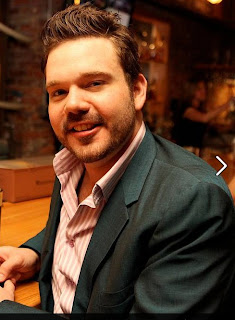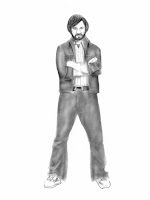 |
| Costume Designer Kristopher Castle |
Actors Theatre Costume Director Kristopher Castle speaks with Keith Waits about designing the upcoming production of True West by Sam Shepard at Actors Theatre of Louisville.
Entire contents are copyright © 2012, Keith Waits. All rights reserved. Published in conjunction with Pure Uncut Candy magazine.
Arts-Louisville: From where do you draw inspiration?
Kristopher Castle: If I’m designing a show, the inspiration can come from any number of sources depending on the period in which its set, or the director, or a concept that myself or the other designers might choose. For True West, it’s drawn straight from history and the socio-economic class of the characters in the show. But if I were to, say, be working on something set in France in 1792, I would be looking at art, painting and sculpture from that time. But for this, I did pictorial research, looking at things such as advertising from the period, things like that.
AL: So research is the first step. How much do you take your cue from the director? Does that change from show to show?
KC: It does. True West, for example, is set in the interior of a house. But the director (Adam Rapp) has chosen to strip away that realism and apply a concept to the play, placing the two actors inside a plexi-glass box, so the characters are like caged animals on display. The play is much more sparse – there aren’t a lot of props – so the costumes are one realistic element, they aren’t stylized in any way. These are actual period pieces that these people would have worn. But sometimes a play is hyper-stylized and the costumes might be distorted shapes or colors inappropriate for a time period. So you take that sort of lead from the director, then the director and the creative team sit down and develop a concept that the characters can live within.
 |
| Sketch for Lee in the upcoming production of True West at Actors Theatre. |
 |
| Lee 2 |
AL: The plexi-glass box sounds intriguing.
KC: Yeah, he’s very excited about the idea that the actors, when they get so physical in the second act, about having their sweat, blood and saliva smeared on the glass walls, reinforcing the image of caged animals getting into some sort of row.
AL: Although the concept is different, the costumes seem closer to how previous productions have depicted the characters.
KC: Austin is a screenwriter and a “preppier” sort of character; he has a family, whereas Lee is the ne’r-do-well brother, ten years older, and he has this late ‘60s early ‘70s rock-a-billy kind of feel. The mother is just returning from a cruise and has a suitcase, so the people themselves will be very realistic, Lee will most likely have tobacco stains on his teeth and dirt under his fingernails. But they will live within this world that is completely different from how the play was written.
 |
| Sketch for Austin in the upcoming production of True West at Actors Theatre. |
 |
| Austin 2 |
AL: There are only four characters in this play. Does that make your job easier?
KC: This isn’t necessarily a complex show. I design the clothes and I wanted to use actual vintage pieces to make it as realistic as possible, which is possible because the period is recent, only 30 to 40 years ago, that it’s not so difficult. If it were an earlier period, something before 1960, there would probably be a lot more building involved.
AL: What is your background? How did you come to be a costume designer?
KC: I went to school at Morehead State University to study theatre. I started as an actor, but it was a very production-based department, so we were able to experience all the different facets of theatre. So in my very first year, I worked as an assistant costume designer and just became fascinated with the transformative process of turning somebody into a character. The next year I designed costumes for two shows and then the following year more than that, etc., etc., and just fell in love with costumes. I worked in summer theatre a lot and then went to New York, where I worked for Playwright’s Horizons. Then I was at Washington National Opera for five years, and then came this job at Actors Theatre. This was always my dream job in Kentucky.
AL: Besides the high-profile reputation, what in particular makes you want to work at Actors Theatre?
KC: When I was in college, I saw a production in the Bingham of Angels in America, which was one of the best productions I had ever seen; the use of space and the design work was so ingenious and the acting was brilliant. It was very inspiring.
AL: It is a pretty daunting schedule of productions, more than most regional companies. Although you don’t design all of the shows yourself, it must be a challenge to be the Resident Costume Designer here.
KC: We have 17 productions a year. Once I know I’m designing a play I immediately go into research mode and start thinking about the different elements, even while I’m working on another show. With the apprentice projects, we actually have the luxury of the entire season to workshop them. The playwrights get to spend time with the cast, and I have plenty of time to speak with the director and suss out ideas and concepts, do a proper sketch and design discussion period and make sure we’re on the same page. Some shows, especially during the Humana Festival, have a much more truncated production period and you have to work more on the fly. I’ll be doing two plays myself, with technical rehearsals only about a week apart.
AL: As Costume Director, how closely do you work with guest designers?
KC: It depends on the show. For instance, Romeo & Juliet (which just recently closed) was set in a modern era, so it was pretty much shopped. The designer came in and shopped for a couple of days, did fittings for another couple of days, and then was out. It was a very quick process. Long Day’s Journey into Night, however, was entirely built, so Lorraine Venberg started working earlier; she was picking her fabrics, then we had to fit those builds into the schedule while Dracula and other shows were being prepared; and we make certain they all get an equal amount of attention, so it’s a lot more work to coordinate all of that.
AL: So it must be a real traffic jam during the Humana Festival?
KC: If we have more than two shows that are heavily built then we’re in trouble. But, fortunately, many of the plays in the Festival tend to be placed in a modern setting and are pretty easily shopped. It makes our job easier. On the other hand, shopping can be difficult because there might be something very specific that you are looking for and you just cannot find it anywhere – where are we going to find that taupe “members only” jacket that has never existed in the real world?
AL: Do you shop online very much?
KC: Oh, yes. There are a lot of great vintage stores online. We found a lot online forTrue West. We just found some vintage Fruit-of-the-Loom underwear – a three-pack of Fruit of the Looms from around 1978!
True West
on-stage at Actors Theatre
November 13 – December 9




